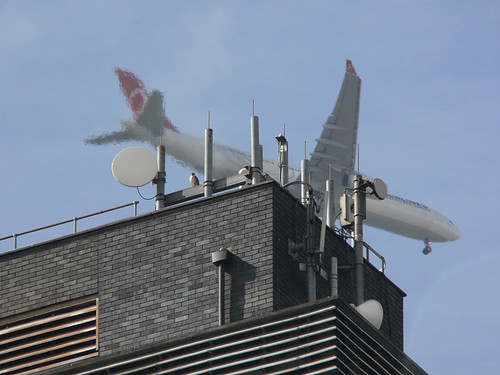
































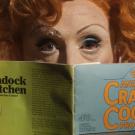















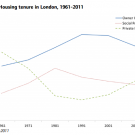





























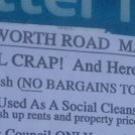























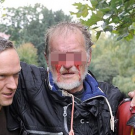











Science: Long commutes fuck you up
Slate’s brilliant Moneybox blog reports on a recent study which breaks down to saying that:
“…a long commute is definitely bad for your blood pressure but it’s positively disastrous if it ends up eating into your physical activity time.”
In other words cycling/walking/running to work are not so bad. Anything that involves being stationary and slipping in and out of a depressive catatonia (looking at you, Tube) is very bad.
There’s now a significant body of evidence connecting long commutes with fatness, poor diet, higher divorce rates, loneliness, and sorrow.
The less time you spend getting to work, the better for your life.
Slate – Long commutes make you fat, give you high blood pressure
Slate – Your commute is killing you
See also:
How London’s tube map tricks you into taking longer routes
Most annoying habits on London public transport
Most annoying bits of bad English on the tube network
12 Jun 2012



















































































































10.30am, and it's already the wettest day of the year
19.4mm and counting in the jurisdiction of NW3 Weather. This beats the previous wettest – 18.5mm on river pageant day last Sunday.
Oh, June.
On the bright side, rain is a great cleanser. Perhaps, just in time for the Olympics, all our sins are being swept away.
11 Jun 2012



















































































































Evening Standard goes all Daily Mail with "sexiest WAG" and "nude dominatrix" stories
“Melanie Slade has been voted the hottest WAG of England’s Euro 2012 squad – while Coleen Rooney came bottom of the poll.”
Thanks, Evening Standard! I’ve been wondering what the consensus was going to be about hot WAG this year.
Something is afoot on the Standard’s recently relaunched website.
Today we have the WAG story, which obviously doesn’t objectify women at all, headlined:
Pictures: Who has been voted sexiest WAG of Euro 2012?
While yesterday we were treated to the following story, whose headline was written in the strange language of SEO rather than English:
Lara Pulver Sherlock dominatrix nude scene wins her best actress nomination
It was, naturally, accompanied by a picture of Lara Pulver Sherlock dominatrix nude scene.
The Daily Mail-ification of London’s dedicated daily newspaper has begun. Hurrah!
See also:
London has chosen its Mayor, why can’t we chose our own media
The Evening Standard: even more pro-Boris than in 2008?
07 Jun 2012



















































































































Wanted in London: a football pub for the connoisseur
Where are the best pubs in London to watch Euro 2012? If you have any interest in drinking and football, you will probably have a personal list of acceptable venues which possess the minimum requirements of a.) having a screen and b.) selling beer.
This may be adequate. But is it really enough?
What if you’re really interested in football?
The sort of person who once completed a Panini stickers album.
The sort of person whose idea of scintillating conversation is attempting to name all the members of the 1993/4 Swindon Town Premier League squad.
The sort of person who owns a Seattle Sounders away kit for no good reason at all.
For you the traditional football pub, with flags in the window and beer on the floor, doesn’t quite do the job. A summary of limitations offensive to your refined sensibility might include:
- A limited selection of the coarser lagers
- Insufficient seating
- No audible match commentary, meaning your apposite punditry cannot be reinforced by official statistics. You also miss out on the thrill a talented commentator’s cadence can lend to a significant moment. (“It’s a great run by Michael Owen…and he might finish it off…OHHHHHHH he’s scored a WONderful goal!”)
- People cheering goals and behaving excitably, rather than cooly analysing the tactical context
- A generally loud atmosphere, precluding reasoned conversation in which you can show off your knowledge of Serie B
What would an ideal pub look like? Seating would be plentiful, the match commentary loud. Each table would be equipped with its own chalkboard so you could bore your companions with alternative tactical setups. Cerebral conversation would be encouraged at the expense of base passions such as excitement and joy.
If you know of such a pub, or a close approximation, please get in touch.
Suggestions to @mikpollitt, or leave them in the comments
Image by Ruth_W on Flickr under Creative Commons
06 Jun 2012



















































































































Some ways a non-monarchist can enjoy the Jubilee without giving up all critical thought
My barber just wished me “a happy Jubilee weekend”, and I realised that people are actually doing this. They’re doing the Jubilee weekend. But how are they doing it? And more importantly, how should they?
For two groups of people, the answer is simple. The unapologetic monarchists are waving their flags and fawning at their hereditary leader. The vituperative republicans are snarking their dissent and being wantonly alternative. Those stranded in the middle find it a quite bewildering place.
What to do if you’re no fan of hereditary wealth and power, but respectful of the power of tradition? If you wouldn’t start with a monarchy, but think that since we’ve got one it probably does less harm than good? You’re neither a republican, nor a monarchist. Let’s call you a monarchnostic*. For you, just as for the small boats bobbing on the choppy waters of Sunday’s river pageant, navigation of the celebrations is perilous indeed.
Here are some options.
1. Suspend all critical thought and just get pissed
A superficially attractive approach, to be sure. If you take this road you will have a good time whether you’re at a street party or a revolutionary rally. But on Wednesday morning, when the hangover pounds inside your skull like a marching band, it will be to the tune of rank intellectual cowardice. Have some self-respect, and keep this option as a last resort.
2. Go to a street party a-ironically
There are several street parties going on this weekend. These will be populated by two groups: ironic cool types wearing “I heart corgi” t-shirts; and unironic line-towers waving flags and singing Rule Britannia. As a thoughtful monarchnostic, it is imperative that you do not identify with either of these factions. If you attend a street party, you must do so a-ironically. You must rid your mind not only of irony, but also the absence of irony. This is no small task. Your best bet is to dress neutrally, talk about the weather and imagine you’re American.
3. A monarchnostic picnic in the park
Think extremely carefully about your choices of venue, food and drink. For East London monarchnostics, (Queen) Victoria Park is obviously out of the question. All Royal Parks should probably be avoided in favour of smaller local greeneries with unobtrusive names. For balance, also steer clear of traditional republican meeting points like statues of people who helped the poor. Once at the park, work even harder than usual to avoid any insects whose social hierarchy culminates in a queen. If you find any, on no account chop off their heads, but try not to let the idle freeloaders feast on your hard-earned vanilla slices.
As far as food goes, Jubilee hampers from M&S have no place here, nor should revolutionary foodstuffs like brioche. Don’t drink anything connected with the British Empire’s history of conquest and subjugation, such as Indian tea, Caribbean rum or Scottish Irn Bru.
4. Choose bunting wisely
To bunt or not to bunt? On balance, discrete bunting may be appropriate for a domestic BBQ, as long as the patterns used avoid flags, heraldry or I heart corgi messages.
5. Enjoy the right bits of the river pageant
Attending an organised Jubilee event need not imply out and out monarchism, as long as you enjoy the right bits. Take pleasure in classical music and historically interesting boats. If the Queen sails past, distance yourself from cheering buffoons, look the lady square in the face and convey by a steely expression and a firm nod that you respect her many hours of work, but do so purely as an equal. Then suspend all critical thought and go and get pissed.
*Linguistic pedants: be reassured – I am aware that making this portmanteau commits a gross crime against the original Greek components, one which I can’t defend and so won’t even try.
01 Jun 2012
Five things hip young urban professionals think are good about their new rented place which are actually rubbish
An outdoor couch is never really this much fun
If you’re lucky enough to have a job which pays enough for you to exercise some choice over where you rent, then you’ll find yourself making some agonised decisions. Is it more important to live close to a good pub or a tube station? Does it matter if there isn’t room to walk around both sides of your bed? How far away are you from the nearest available hummus?
Here are five things people think are good about prospective houses or flats when they see them advertised on gumtree, but which are, once moved in, a bitter disappointment.
1. A roof terrace – “for parties”
The ideal: There’s this roof terrace, yeah, with amazing views of the London skyline. You can see Canary Wharf/The Gherkin/The Shard and at night the city lights up before your eyes. We’ll take a couch up there, somehow, and have parties and through the haze of alcohol, for a special moment denied to people whose homes don’t have roof terraces, we’ll feel at one with our city, our neighbours, and ourselves.
The reality: The couch won’t fit up the stairs, and the pouf you took up there instead now rots, rain-soaked, in the corner, lending the whole terrace a grim abandoned air. You can see the top eighth of The Gherkin poking out above the concrete tower block opposite. It’s freezing up there. Shall we go back downstairs?
2. An open kitchen/lounge – “for dinner parties”
The ideal: We’ll have dinner parties and invite all our friends round and it’ll be great because I’ll be able to keep an eye on the roast peppers while still talking to everyone. It’ll be like cooking as a form of theatre, yeah?!
The reality: By day, a flotilla of flies buzz round your three-week old washing up, distracting you from watching Pointless on BBC1. By night, friends judge you for your poor chopping technique and lamentable pan management.
3. A balcony – “for growing herbs and shit”
The ideal: We’ll have rosemary, and thyme, and tomatoes – we’ll grow tomatoes from seed. They’ll feed us all summer! And in winter we’ll grow winter vegetables, whatever they are, and they’ll all taste so much better because we’ll have grown it ourselves on our own little piece of outdoors right in the heart of the city.
The reality: It faces north, up against the wall of a warehouse/exhibition space. It’s so dark the only thing that will grow there is cress. Who likes cress?
4. Other young urban professionals as neighbours – “for a really cool vibe”
The ideal: Our current friends are alright, but wouldn’t be great to have some new friends? Meet some different people? Not people different from us, we don’t want to mix with those. People that are like us but new. You know? We can have them round for dinner and have parties on the roof terrace and swap herbs with them and it’ll be like our own little village community, except on the 5th floor of a gated apartment complex.
The reality: What is with those people upstairs playing drum ‘n’ bass at all hours on a Tuesday night? And what about that couple next door who stay inside the whole time like weird recluses and complained when I left my bike in the communal entrance? What’s wrong with all these people? They aren’t like me at all!
5. A dishwasher
The ideal: It washes dishes.
The reality: Actually this one is pretty great.
See also:
The 5 best places in London to break up with someone
The five best frozen pizzas on the London convenience store market, ranked by value
The 5 best places in London to drink alone
Five filthy, dirty, obscenely sexual poems from the past
Annoying habits of Londoners #8: Keeping spreadsheets of their dates
31 May 2012



















































































































Average: win gold medal. Interesting: The Royal Mail issues a stamp of you winning a gold medal. Amazing: The next day

30 May 2012



















































































































As Chicago sets a target of zero road deaths, where is our Road Safety Plan?
Atlantic Cities reports on Chicago’s new transport plan:
“Eliminate all pedestrian, bicycle, and overall traffic crash fatalities within 10 years. That is the first “performance measure” listed in the safety section of the Chicago plan, which also calls for a 50 percent reduction of roadway injuries to pedestrians, bicycles, and motorists in five years.”
That target of 0 deaths on the road has raised eyebrows. How can it be achieved? The plan will include:
“…engineering local streets to reduce car speeds; improving pedestrian and bike facilities; education; better data collection and evaluation; and increasing enforcement. Mayor Rahm Emanuel is strongly behind such measures even when they are politically unpopular, as was the case with a controversial speed camera bill that the mayor pushed through the City Council last month.”
This is only a plan, for sure. But it’s an ambitious one aimed at protecting the lives of the city’s people.
It’s also politically brave. Set yourself a target as tough as this, and there’s a good chance you will fail. But even failure might save lives.
How does London measure up?
Road deaths are falling. 126 people died on London’s roads in 2010, down 57% in 10 years. Chicago averages about 50 deaths a year.
Road safety was a live issue in the Mayoral and London Assembly election earlier this month, chiefly thanks to the vocal efforts of cyclists. Last year in London 16 cyclists lost their lives, and so far 5 have died in 2012 (details here).
And yet the city’s latest (PDF) Road Safety Plan dates from 2001 and carries a foreword by Ken Livingstone. Green Assembly Member Jenny Jones asked Mayor Johnson for an update on when we might see a new one in January this year:
“Why has your draft London Road Safety Plan failed to appear, despite three years of promises that it would? Will you now have time to formally consult the London Assembly on the document as you promised and to finalise it ahead of the pre-election period?”
His response, paraphased: “We’re working on it.”
The 2001 plan set targets for reducing deaths and serious injuries by 40% by 2010. This was achieved ahead of schedule, so in 2006 new targets of a further 50% reduction in deaths and serious injuries by 2010 were announced. These targets, set 6 years ago and with an end date 2 years ago, are the latest that I can find. There do not appear to be any current published targets for reducing deaths on our roads.
I have asked TfL for an update on when the new plan will appear and what the current targets for casualty reduction are. If they ever get back to me, I’ll post their response.
Atlantic Cities – Chicago’s Ambitious Plan for Zero Traffic Fatalities
PDF of the 2001 Road Safety Plan
A couple of Jenny Jones’ questions, Nov 2010, Jan 2012 on when a new plan might appear
Spreadsheet of cycling deaths and serious injuries on London’s roads since 2006.
30 May 2012



















































































































Brent council launches daring night-time raid against its own library books
“On the advice of the police, the council removed its property from the building in the early hours of the morning.”
So, according to the Independent, say Brent Council after sending removal men round to Kensal Rise Library at 3am on Tuesday morning to take out all the books. The council say they will be distributed round the borough’s other libraries. Campaigners don’t see why they can’t stay where they are.
The council tried to remove the books in the hours of daylight two weeks ago but were scared off by a bunch of local residents, including a couple of authors. So they came back in the darkness, when even authors must sleep.
One of them, Maggie Gee, calls it “cowardice”. Whether or not you think libraries have a future in the digital age, it’s hard to argue with that.
Independent – Kensal Rise Library to be sold or rented out after Brent council’s 3am raid to strip it of books
30 May 2012
Interviewed: @FaBPeregrines on the wild hunters stalking the city skies
“I just love them,” says Nathalie Mahieu. “The first time I saw one I was immediately hooked.”
Nathalie is talking about Tom and Charlie, a pair of peregrine falcons who have been living on the roof of Charing Cross Hospital in Fulham since late 2007. Each year since they have roosted there. Each day they have killed something.
Nathalie feels very close to them. Five years ago it was she who spotted their arrival, and now she is their representative in the human world. She’s their Twitter feed, their blog, their Flickr group and the recorder of their lives. This closeness is no surprise, for she can see the birds from her living room.
This spring, so can everyone else. A live webcam, set up by Big Cat Diary and Springwatch naturalist Simon King, is trained on the nest and can be watched online, from any living room, iPad or phone, 24 hours a day.
The webcam has changed things.
“There’s been a huge upsurge in interest this year,” says Nathalie, whose Twitter following has quadrupled in the last few months. “When the chicks hatched, the webcam site crashed.”
There are three chicks (the adults trod on their fourth egg), fluffy bundles of down who can look adorable until they are chomping down macerated parakeet flesh, as lurid green newly-plucked feathers swirl around them on the breeze. The webcam doesn’t come with a watershed. Songbirds are filleted for lunch. It’s unedited, brutal truth, like reality TV was always supposed to be.
As Springwatch has shown, live coverage of the animals amongst us can make compelling viewing. The storylines are the made from the most elemental dramas: heroes and villains, chance and fate, life and death. The setting, above a hospital, with the gravestones of a cemetery visible in the background below the nest, is a location manager’s dream.
Peregrines make fine stars. If charm can be defined as “a hint of danger”, then these birds almost have too much. And they have the looks to go with it: sharp talons, sharp beaks, sharp eyes. They seek the limelight, having been spotted on Tate Modern, the girders of the O2, and the Houses of Parliament. And what’s more, says Nathalie, “they are happy to nest in man made boxes with cameras near them”.
They also have a history, and a language, so rich it can’t help but compel. Their ancestral nests are called eyries, their chicks eyasses, the adult male is a tiercel. Their attack dive, which reaches world-beating, scarcely credible speeds in excess of 250mph, is called a stoop. This is the specialised vocabularly of a very special bird.
Driven almost to extinction in the UK by pesticide use in the middle of the last century, they have rebounded in recent years and made cities their home in a way few big wild predators, save perhaps the urban fox, have managed.
Nathalie says there are a certain 25 pairs in the Greater London area, though the number of individuals will probably be higher. It’s a story repeated in cities across the world. From the cathedrals of Barcelona to the skyscrapers of New York , the birds are coming back. They find cliffs in our sheer concrete buildings, and plentiful prey in the pigeons plumped up by human crumbs.
Humans tend not be good at living with wild animals, especially ones which kill as much as we do. But perhaps the webcam points to a more tolerant future.
“It’‘s a very positive thing. When you involve local people [they] become their birds,” Nathalie says. The more people know, the more people will look out for them, and the better their chances will be.
And yet the camera can only convey so much. I ask Nathalie once more, what it is about these birds which draws her in. “I just love them”, she says again. She’s not alone. In 1967, in the darkest days of the pesticide plague when peregrines were almost driven from the land, an unknown librarian called JA Baker published a book which remains a classic of natural history. In remarkable prose, he describes a winter spent chasing the birds through the Essex countryside. For him, as for Nathalie, it was love at first sight.
“I…saw a falcon flying towards me. It veered to the right, and passed inland. It was like a kestrel, but bigger and yellower, with a more bullet-shaped head, longer wings, and greater zest and buoyancy of flight. It did not glide till it saw starlings feeding in stubble, then it swept down and was hidden among them as they rose. A minute later it rushed overhead and was gone with a breath into the sunlit mist. This was my first peregrine.”
These birds have made the city their home. The question now is whether we will let them stay.
See also:
The live webcam
@FaBPeregrines
London Peregrines website
Peregrine by JA Baker
Follow Mike
Twitter: @MikPollitt
Email: michael.pollitt@snipelondon.com
22 May 2012
Snipe Highlights
Some popular articles from past years
- Punk brewery just as sexist and homophobic as the industry they rail against
- Silencing the Brick Lane curry touts could be fatal for the city's self-esteem
- Diary of the shy Londoner
- Hope and despair in Woolwich town centre
- Nice map of London's fruit trees shows you where to pick free food
- Margaret Thatcher statue rejected by public
- The five spookiest abandoned London hospitals
- Summer Camp: Roll out those lazy, hazy, crazy days
- Only 16 commuters touch in to Emirates Air Line, figures reveal
- Nice Interactive timeline lets you follow Londoners' historic fight against racism
© 2009-2025 Snipe London.




